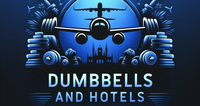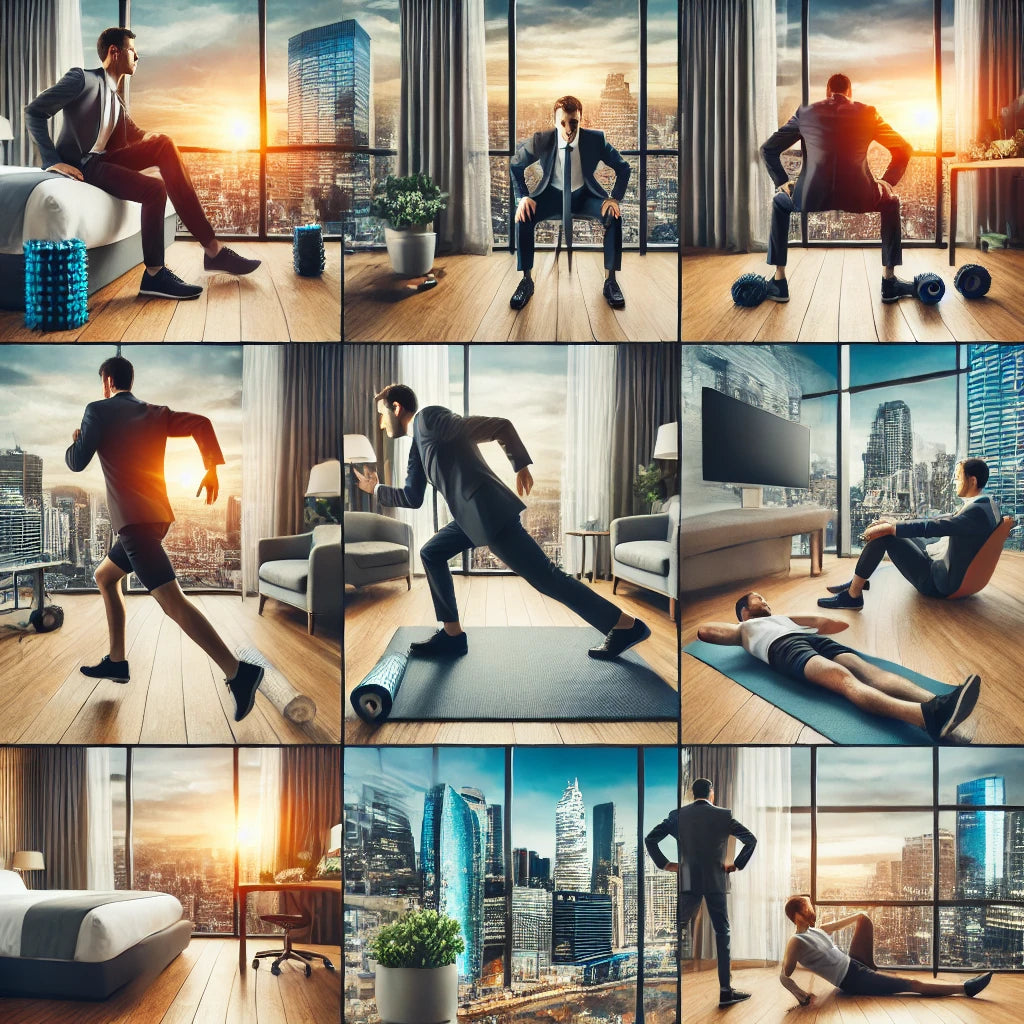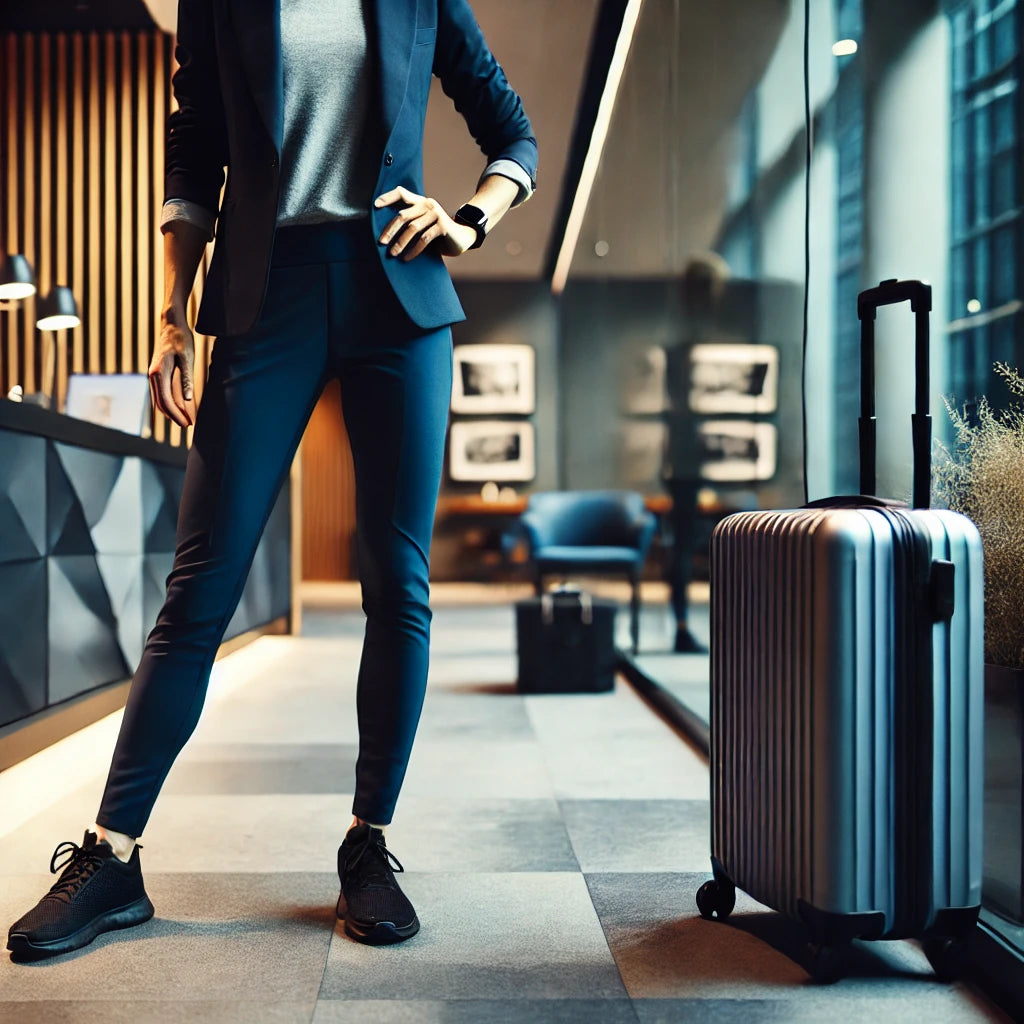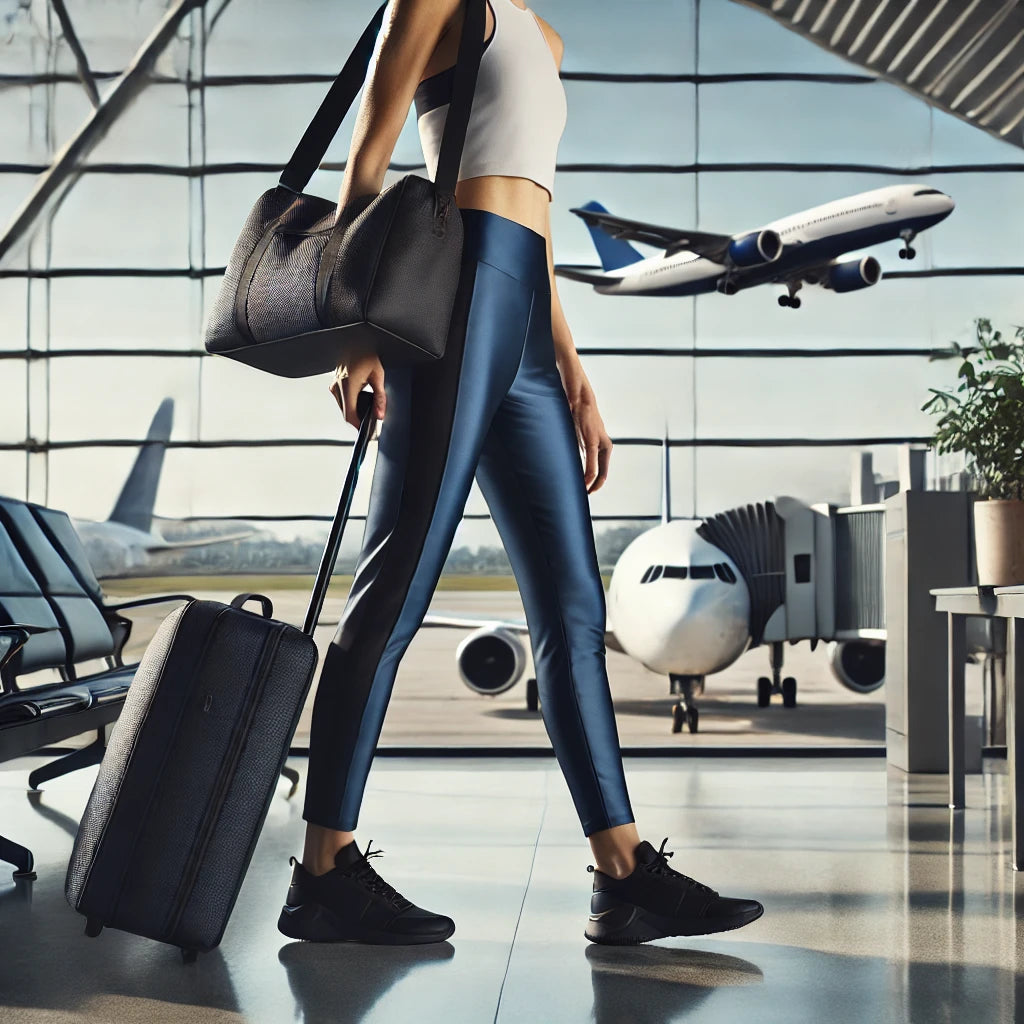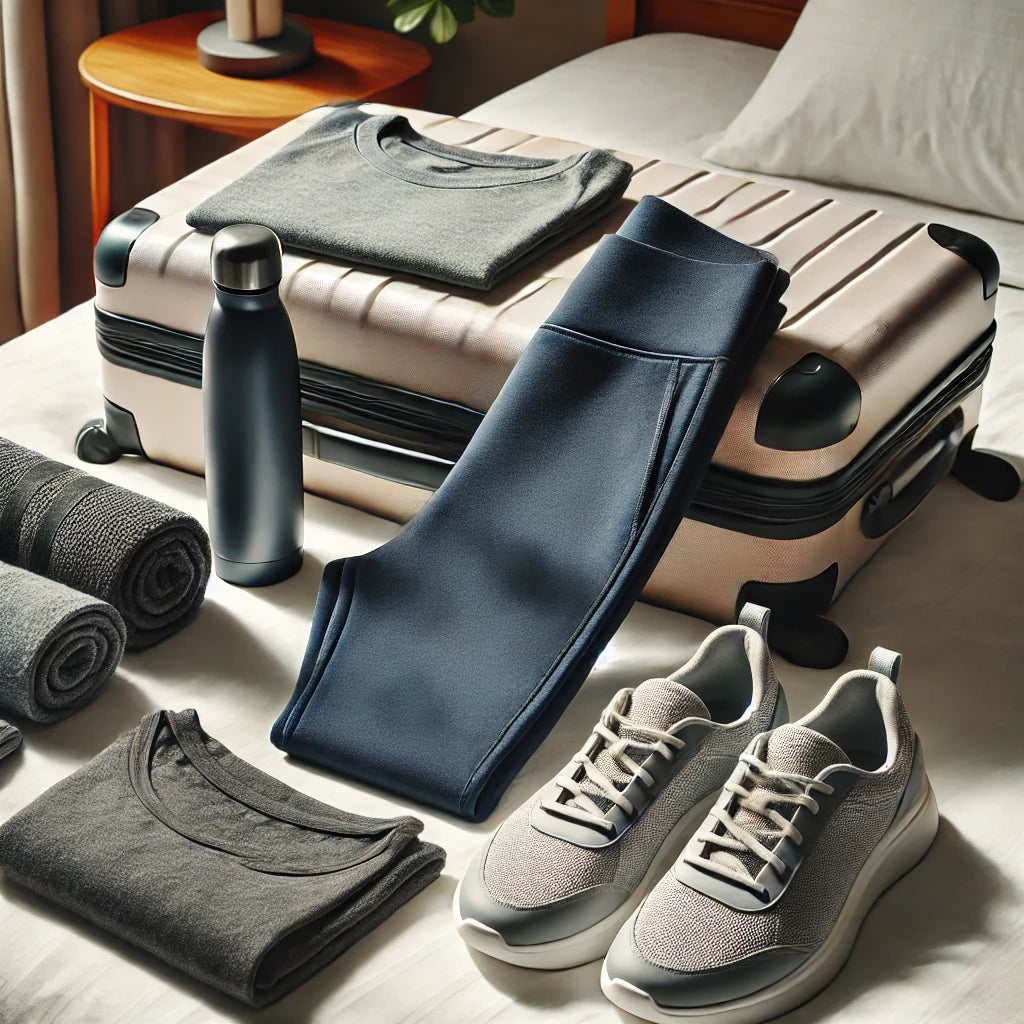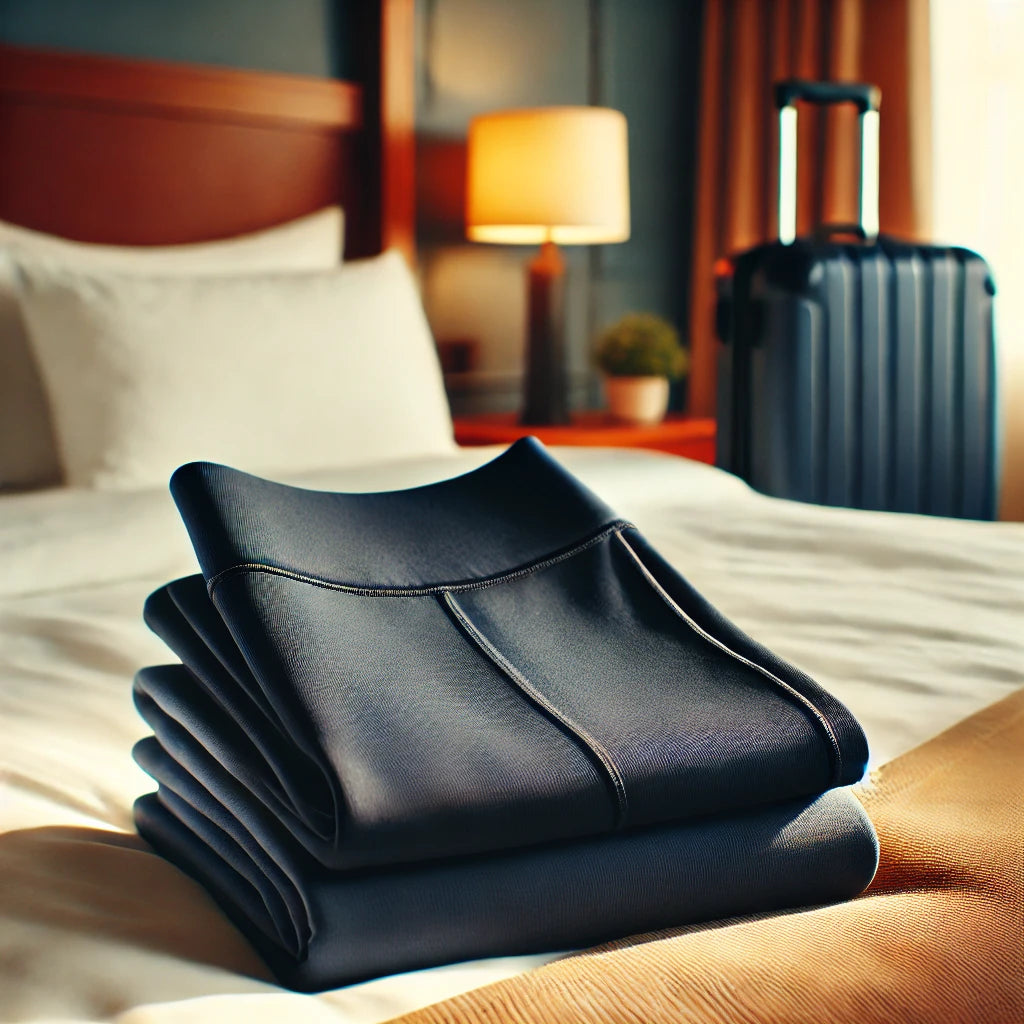As a traveling professional, finding time to maintain your fitness routine can be challenging amidst tight schedules and frequent travel. However, staying fit doesn't have to be a time-consuming endeavor. With our quick and effective 30-minute workouts, you can achieve your fitness goals without sacrificing precious time. Designed specifically for busy travelers like flight attendants, travel nurses, and business executives, these efficient routines can be performed in the comfort of your hotel room or a compact gym. Embrace these workouts to stay active, energized, and healthy on the go, ensuring you always perform at your best, no matter where your travels take you.

The Importance of Fitness for Traveling Professionals
Staying Energized and Focused
Regular exercise is crucial for maintaining energy levels and mental focus, both of which are essential for high-performing professionals. Traveling can be exhausting, and without a consistent fitness routine, it's easy to fall into a cycle of fatigue and decreased productivity. Engaging in 30-minute workouts can help combat this by boosting your energy levels and improving cognitive function.
Combatting the Physical Toll of Travel
Extended periods of sitting, whether on planes, trains, or in meetings, can lead to poor posture, muscle stiffness, and even long-term health issues. Incorporating efficient routines into your daily schedule helps to alleviate these issues, ensuring that your body remains flexible, strong, and resilient against the physical demands of travel.
Enhancing Mental Health
The stress of constantly being on the move can take a toll on your mental health. Exercise is a proven way to reduce stress, anxiety, and depression. By committing to regular 30-minute workouts, you can maintain a positive mindset and better handle the challenges that come with a busy travel schedule.
Planning Your 30-Minute Workouts
Assess Your Schedule
The first step in integrating fitness into your travel routine is assessing your schedule. Identify gaps in your day where you can fit in a quick workout. Early mornings, lunch breaks, or evenings after work are typically ideal times for most traveling professionals.
Choose Accessible Workouts
When you're on the go, accessibility is key. Select exercises that require minimal equipment and can be performed in small spaces, such as hotel rooms or hotel gyms. Bodyweight exercises, resistance bands, and dumbbell routines are excellent choices.
Set Realistic Goals
Establishing clear, achievable fitness goals will keep you motivated and focused. Whether it's maintaining your current fitness level, losing weight, or building muscle, having a goal in mind will guide your workout choices and help you stay committed.
Efficient Routines for Hotel Room Workouts
High-Intensity Interval Training (HIIT)
HIIT is one of the most efficient workout styles for those with limited time. It involves short bursts of intense exercise followed by brief rest periods. This method maximizes calorie burn and boosts your metabolism.
Sample HIIT Routine
- Warm-Up (5 minutes)
- Jumping Jacks: 1 minute
- High Knees: 1 minute
- Arm Circles: 1 minute
- Bodyweight Squats: 1 minute
- Lunges: 1 minute
- Workout (20 minutes)
- Burpees: 1 minute, rest for 30 seconds
- Mountain Climbers: 1 minute, rest for 30 seconds
- Push-Ups: 1 minute, rest for 30 seconds
- Jump Squats: 1 minute, rest for 30 seconds
- Plank: 1 minute, rest for 30 seconds
- Repeat the circuit 2 more times
- Cool Down (5 minutes)
- Stretching: Focus on major muscle groups, hold each stretch for 30 seconds
Bodyweight Strength Training
Bodyweight exercises are perfect for building strength and can be done anywhere, without the need for equipment.
Sample Bodyweight Routine
- Warm-Up (5 minutes)
- Jogging in Place: 2 minutes
- Arm Swings: 1 minute
- Hip Circles: 1 minute
- Dynamic Stretching: 1 minute
- Workout (20 minutes)
- Push-Ups: 15 reps
- Bodyweight Squats: 20 reps
- Tricep Dips: 15 reps (using a chair)
- Walking Lunges: 20 reps (10 each leg)
- Bicycle Crunches: 15 reps each side
- Repeat the circuit 3 times
- Cool Down (5 minutes)
- Stretching: Focus on major muscle groups, hold each stretch for 30 seconds
Resistance Band Workouts
Resistance bands are portable and versatile, making them an excellent addition to your travel fitness gear.
Sample Resistance Band Routine
- Warm-Up (5 minutes)
- Marching in Place: 2 minutes
- Shoulder Rolls: 1 minute
- Side Lunges: 1 minute
- Arm Swings: 1 minute
- Workout (20 minutes)
- Banded Squats: 15 reps
- Banded Push-Ups: 15 reps
- Banded Rows: 15 reps each side
- Banded Deadlifts: 15 reps
- Banded Bicycle Crunches: 15 reps each side
- Repeat the circuit 3 times
- Cool Down (5 minutes)
- Stretching: Focus on major muscle groups, hold each stretch for 30 seconds

Customizing Your Travel Workout Plan
Tailoring Workouts to Your Fitness Level
It's important to choose exercises that match your current fitness level. If you're a beginner, start with basic movements and gradually increase the intensity. For more advanced exercisers, incorporate complex movements and heavier resistance to continue challenging your body.
Incorporating Flexibility and Mobility
Flexibility and mobility exercises are often overlooked but are crucial for preventing injuries and maintaining a full range of motion. Include stretching and mobility drills in your warm-up and cool-down routines.
Sample Flexibility Routine
- Warm-Up (5 minutes)
- Gentle Jog: 2 minutes
- Arm Circles: 1 minute
- Hip Circles: 1 minute
- Dynamic Stretching: 1 minute
- Workout (20 minutes)
- Forward Fold Stretch: 1 minute
- Cat-Cow Stretch: 1 minute
- Child’s Pose: 1 minute
- Pigeon Pose: 1 minute each side
- Downward Dog: 1 minute
- Repeat the circuit 3 times
- Cool Down (5 minutes)
- Gentle stretching: Focus on major muscle groups, hold each stretch for 30 seconds
The Benefits of Regular Exercise for Traveling Professionals
Improved Physical Health
Regular exercise helps maintain a healthy weight, reduces the risk of chronic diseases, and improves cardiovascular health. For traveling professionals, staying fit ensures you can keep up with the demands of your job without compromising your health.
Enhanced Mental Well-Being
Exercise is a powerful tool for mental health. It releases endorphins, which improve mood and reduce stress. For those constantly on the move, maintaining a regular workout routine can be a crucial factor in managing the psychological demands of travel.
Increased Productivity
Physical fitness is directly linked to productivity. Regular exercise improves focus, boosts energy levels, and enhances cognitive function, allowing traveling professionals to perform better in their roles.
Overcoming Common Challenges
Lack of Time
Time constraints are a significant barrier for many traveling professionals. By focusing on 30-minute workouts, you can fit exercise into your schedule without sacrificing other important activities.
Limited Space
Hotel rooms and small gyms can be challenging environments for workouts. Choosing exercises that require minimal space and equipment ensures you can stay fit regardless of your surroundings.
Maintaining Motivation
Staying motivated can be difficult when you're constantly on the go. Setting clear goals, tracking your progress, and finding enjoyment in your workouts are key strategies for maintaining motivation.
Tips for Staying Consistent
Create a Workout Schedule
Planning your workouts ahead of time increases the likelihood that you'll stick to them. Set aside specific times each day for exercise, just as you would for any other important appointment.
Use Fitness Apps
Fitness apps can provide guidance, track your progress, and offer motivation. Many apps offer quick workout routines that you can do anywhere, making them ideal for traveling professionals.
Join Online Fitness Communities
Connecting with others who share your fitness goals can provide support and accountability. Online fitness communities offer a platform for sharing tips, encouragement, and progress.

Nutrition Tips for Traveling Professionals
Plan Your Meals
Planning your meals in advance can help you make healthier choices and avoid the temptation of fast food. Look for restaurants that offer nutritious options or prepare simple, healthy meals in your hotel room.
Stay Hydrated
Travel can be dehydrating, especially air travel. Carry a reusable water bottle and aim to drink plenty of water throughout the day to stay hydrated.
Choose Balanced Meals
Opt for meals that include lean proteins, whole grains, and plenty of vegetables. Avoid foods that are high in sugar, salt, and unhealthy fats, which can negatively impact your energy levels and overall health.
Pack Healthy Snacks
Healthy snacks like nuts, fruits, and protein bars can help you avoid unhealthy options when you're on the go. Keep these snacks handy for quick energy boosts between meals.
Importance of Rest and Recovery
Adequate Sleep
Quality sleep is essential for recovery and overall health. Aim for 7-9 hours of sleep per night, and try to maintain a consistent sleep schedule even when traveling across time zones.
Active Recovery
Incorporating low-intensity activities like walking, yoga, or stretching into your routine can aid recovery and prevent injuries. Active recovery helps increase blood flow to your muscles without putting too much strain on your body.
Listen to Your Body
Pay attention to how your body feels and adjust your workouts accordingly. If you're experiencing pain or extreme fatigue, take a rest day or opt for a lighter workout.
Use Recovery Tools
Tools like foam rollers, massage balls, and compression garments can help alleviate muscle soreness and improve flexibility. Incorporate these tools into your post-workout routine to enhance recovery.
Detailed Analysis of Efficient 30-Minute Workouts
High-Intensity Interval Training (HIIT)
Understanding HIIT
HIIT is a form of interval training that alternates between short periods of intense anaerobic exercise and less intense recovery periods. These workouts are designed to keep your heart rate up and burn more fat in less time. The intensity of these exercises ensures that you can achieve significant fitness benefits in just 30 minutes.
Benefits of HIIT for Travelers
- Efficient Fat Burning: HIIT workouts can burn a significant number of calories in a short period, making them ideal for those looking to maintain or lose weight.
- Increased Metabolism: The intensity of HIIT keeps your metabolism elevated for hours after your workout, known as the afterburn effect.
- Improved Cardiovascular Health: HIIT can improve heart health and endurance, which is beneficial for overall fitness and well-being.
- Minimal Equipment: Many HIIT exercises require little to no equipment, making them perfect for hotel rooms or small gym spaces.
Sample HIIT Exercises Explained
- Burpees: Begin in a standing position, drop into a squat with your hands on the ground, kick your feet back into a plank, return your feet to the squat position, and jump up.
- Mountain Climbers: Start in a plank position. Quickly alternate bringing one knee to your chest and then back to the starting position, as if you are running in place horizontally.
- Push-Ups: From a plank position, lower your body until your chest nearly touches the floor, then push yourself back up.
- Jump Squats: Perform a squat, then explode upwards into a jump. Land softly and immediately go into the next squat.
Bodyweight Strength Training
Why Bodyweight Exercises are Ideal for Travelers
Bodyweight exercises are practical for traveling professionals because they require no equipment and can be done anywhere. These exercises use your body weight as resistance, which can effectively build strength and endurance.
Detailed Breakdown of Key Bodyweight Exercises
- Push-Ups: These work the chest, shoulders, and triceps. Variations like wide push-ups, diamond push-ups, and incline push-ups can target different muscle groups.
- Bodyweight Squats: Squats target the lower body, including the quadriceps, hamstrings, and glutes. Variations include sumo squats, single-leg squats, and pulse squats.
- Tricep Dips: Using a chair, lower and raise your body to target the triceps. Ensure your back stays close to the chair to maximize the workout.
- Walking Lunges: These are excellent for leg strength and stability. Walking lunges also engage your core as you maintain balance.
- Bicycle Crunches: This exercise targets the abdominal muscles and obliques. Ensure to perform them slowly to engage the muscles effectively.
Resistance Band Workouts
Advantages of Using Resistance Bands
Resistance bands are lightweight, portable, and versatile, making them an excellent choice for travelers. They provide continuous resistance throughout each movement, helping to build strength and muscle.
Sample Resistance Band Exercises
- Banded Squats: Place a resistance band above your knees, squat down, and return to the starting position. The band adds resistance to your legs and glutes.
- Banded Push-Ups: Wrap a band around your back and hold it under your hands. Perform push-ups as usual, with added resistance.
- Banded Rows: Anchor the band to a stable object, pull the band towards your waist while keeping your elbows close to your body, targeting your back muscles.
- Banded Deadlifts: Stand on the band with feet hip-width apart, hold the handles, and perform a deadlift motion. This targets the hamstrings, glutes, and lower back.
- Banded Bicycle Crunches: Wrap the band around your feet, perform bicycle crunches for added resistance to your abs and obliques.

Customizing Your Travel Workout Plan
Assessing Your Fitness Level
Before starting any workout routine, it's important to assess your current fitness level. This will help you choose the right exercises and avoid injury. Consider factors such as your current exercise routine, any existing injuries, and your fitness goals.
Beginner Level
If you're new to exercise or returning after a long break, start with basic movements and gradually increase the intensity. Focus on mastering the correct form to prevent injuries.
Intermediate Level
For those who have been exercising regularly, you can incorporate more challenging exercises and increase the intensity. Adding variations and resistance can help you continue to progress.
Advanced Level
Experienced exercisers can perform complex movements and use heavier resistance. Focus on challenging your body with advanced exercises and high-intensity routines to keep progressing.
Incorporating Flexibility and Mobility
Importance of Flexibility and Mobility
Flexibility and mobility exercises are essential for maintaining a full range of motion and preventing injuries. These exercises can help improve posture, reduce muscle tension, and enhance overall physical performance.
Effective Flexibility and Mobility Exercises
- Dynamic Stretching: Perform dynamic stretches like leg swings, arm circles, and torso twists to prepare your muscles for exercise.
- Yoga Poses: Incorporate yoga poses like Downward Dog, Child’s Pose, and Cat-Cow Stretch to improve flexibility and relieve tension.
- Foam Rolling: Use a foam roller to release tight muscles and improve mobility. Focus on areas like the back, quads, and calves.
Enhancing Mental Well-Being Through Exercise
Stress Reduction
Exercise is a natural stress reliever. Physical activity increases the production of endorphins, which are natural mood lifters. Regular exercise can help manage stress, anxiety, and depression, making it an essential component of mental well-being for traveling professionals.
Improving Sleep Quality
Regular exercise can improve the quality of your sleep. Physical activity helps regulate your sleep patterns and reduces symptoms of insomnia. For traveling professionals, quality sleep is crucial for maintaining productivity and overall health.
Boosting Confidence and Mood
Regular exercise can boost self-esteem and confidence. Achieving fitness goals and seeing progress can provide a sense of accomplishment, which positively impacts your mood and outlook on life.
Overcoming Common Challenges
Managing Jet Lag with Exercise
Jet lag can be a significant challenge for traveling professionals. Exercise can help reset your internal body clock and adjust to new time zones more quickly. Aim to get some light exercise, like a walk or stretching, upon arrival at your destination.
Staying Active During Long Flights
Sitting for long periods during flights can lead to stiffness and discomfort. Try to move around the cabin when possible, and perform simple stretches in your seat to maintain circulation.
Finding Time for Exercise
Balancing a busy work schedule with exercise can be challenging. Plan your workouts in advance, and look for opportunities to incorporate physical activity into your day, such as taking the stairs or walking between meetings.
Tips for Staying Consistent
Establishing a Routine
Consistency is key to maintaining fitness while traveling. Establish a routine that fits your schedule and stick to it. Consistency helps form habits, making it easier to stay committed to your workouts.
Setting Achievable Goals
Set realistic and achievable fitness goals. Having clear objectives helps you stay focused and motivated. Whether it's maintaining your current fitness level, losing weight, or building muscle, having specific goals will guide your workout choices.
Keeping a Workout Journal
Track your workouts and progress in a journal. Note the exercises you perform, the duration, and how you felt during and after the workout. This will help you see your progress and stay committed to your fitness routine.
Finding Enjoyment in Exercise
Choose workouts that you enjoy. If you find exercise enjoyable, you're more likely to stick with it. Experiment with different types of workouts to find what you like best, whether it's HIIT, strength training, yoga, or something else.
Nutrition Tips for Traveling Professionals
Eating Healthy on the Go
Maintaining a healthy diet while traveling can be challenging, but it's essential for overall health and fitness. Plan your meals in advance, and look for restaurants that offer nutritious options. Avoid fast food and processed snacks, which can negatively impact your energy levels and health.
Importance of Hydration
Staying hydrated is crucial, especially during travel. Carry a reusable water bottle and aim to drink plenty of water throughout the day. Avoid excessive caffeine and alcohol, which can contribute to dehydration.
Balanced Meals
Choose balanced meals that include lean proteins, whole grains, and plenty of vegetables. Avoid foods that are high in sugar, salt, and unhealthy fats. Eating balanced meals will help maintain your energy levels and overall health.
Healthy Snacking
Healthy snacks like nuts, fruits, and protein bars can help you avoid unhealthy options when you're on the go. Keep these snacks handy for quick energy boosts between meals. Choose snacks that are high in protein and fiber to keep you full and satisfied.

Importance of Rest and Recovery
Quality Sleep
Quality sleep is essential for recovery and overall health. Aim for 7-9 hours of sleep per night, and try to maintain a consistent sleep schedule even when traveling across time zones. Proper rest allows your body to repair and rejuvenate, ensuring you can perform at your best.
Active Recovery Techniques
Incorporating low-intensity activities like walking, yoga, or stretching into your routine can aid recovery and prevent injuries. Active recovery helps increase blood flow to your muscles without putting too much strain on your body.
Using Recovery Tools
Tools like foam rollers, massage balls, and compression garments can help alleviate muscle soreness and improve flexibility. Incorporate these tools into your post-workout routine to enhance recovery. Regular use of these tools can help prevent injuries and maintain muscle health.
Listening to Your Body
Pay attention to how your body feels and adjust your workouts accordingly. If you're experiencing pain or extreme fatigue, take a rest day or opt for a lighter workout. Listening to your body helps prevent overtraining and injuries.
Customizing Your Travel Workout Plan
Tailoring Workouts to Your Fitness Level
It's important to choose exercises that match your current fitness level. If you're a beginner, start with basic movements and gradually increase the intensity. For more advanced exercisers, incorporate complex movements and heavier resistance to continue challenging your body.
Creating a Balanced Routine
A balanced workout routine includes a mix of cardiovascular, strength, and flexibility exercises. This ensures that all aspects of fitness are addressed, helping you achieve overall health and wellness.
Incorporating Variety
Variety is important to prevent boredom and keep your body challenged. Incorporate different types of workouts, such as HIIT, strength training, and flexibility exercises, to keep your routine interesting.
Tracking Progress
Keep a record of your workouts, noting the exercises, duration, and how you felt. Tracking your progress will help you stay motivated and make necessary adjustments to your plan. Use a fitness app or journal to monitor your progress and set new goals.
Enhancing Performance with Nutrition
Pre-Workout Nutrition
What you eat before your workout can impact your performance. Aim to eat a balanced meal or snack that includes carbohydrates and protein about 1-2 hours before exercising. Good options include a banana with peanut butter, oatmeal with fruit, or a protein shake.
Post-Workout Nutrition
After your workout, it's important to refuel your body with nutrients to aid recovery. Eat a meal or snack that includes protein and carbohydrates within 30-60 minutes of finishing your workout. Examples include a turkey sandwich, Greek yogurt with berries, or a smoothie with protein powder.
Staying Hydrated
Proper hydration is crucial for optimal performance. Drink water before, during, and after your workouts to stay hydrated. If you're exercising in hot conditions or for extended periods, consider a sports drink to replenish electrolytes.
Balanced Diet
Maintaining a balanced diet is essential for overall health and fitness. Include a variety of foods in your diet, such as lean proteins, whole grains, fruits, vegetables, and healthy fats. Avoid excessive sugar, salt, and unhealthy fats, which can negatively impact your health.
Incorporating Exercise into Your Travel Routine
Making Use of Hotel Amenities
Many hotels offer fitness facilities, such as gyms and swimming pools. Take advantage of these amenities to stay active. If your hotel doesn't have a gym, you can still perform bodyweight exercises or use resistance bands in your room.
Exploring Local Fitness Options
Look for local fitness options, such as parks, fitness classes, or gyms, at your travel destination. Exploring new environments can make your workouts more exciting and less monotonous.
Staying Active Throughout the Day
Incorporate physical activity into your daily routine, even when you're not working out. Walk instead of taking a taxi, use the stairs instead of the elevator, and take short breaks to stretch or move around during meetings.
Planning Ahead
Plan your workouts in advance to ensure you stay consistent. Schedule your workouts just as you would any other important appointment. Having a plan helps you stay committed to your fitness goals.
Utilizing Technology to Enhance Workouts
Fitness Apps
Fitness apps can provide guidance, track your progress, and offer motivation. Many apps offer quick workout routines that you can do anywhere, making them ideal for traveling professionals. Popular apps include MyFitnessPal, Nike Training Club, and Fitbit.
Online Workouts
Online workouts offer convenience and variety. Many fitness websites and YouTube channels provide free workout videos that you can follow along with in your hotel room. Look for reputable sources to ensure the workouts are effective and safe.
Wearable Technology
Wearable technology, such as fitness trackers and smartwatches, can help monitor your activity levels, heart rate, and sleep patterns. These devices can provide valuable insights into your fitness progress and help you stay motivated.
Virtual Fitness Communities
Join virtual fitness communities to connect with others who share your fitness goals. These communities offer support, encouragement, and accountability, helping you stay committed to your workouts. Participate in challenges, share progress, and gain motivation from others.

Maintaining Fitness on Long Trips
Establishing a Routine
When you're on a long trip, establishing a routine can help maintain consistency in your workouts. Plan your daily schedule to include time for exercise, meals, and rest. Having a routine helps you stay organized and committed to your fitness goals.
Adjusting to Time Zones
Traveling across time zones can disrupt your sleep and exercise schedule. To minimize the impact of jet lag, gradually adjust your sleep schedule before your trip. Once you arrive at your destination, get some light exercise and exposure to natural light to help reset your internal clock.
Staying Motivated
Staying motivated on long trips can be challenging. Set short-term goals and reward yourself for achieving them. Keep in mind the long-term benefits of staying fit, such as improved energy levels, better health, and enhanced productivity.
Adapting to Different Environments
Be flexible and adaptable with your workouts. If you don't have access to a gym, use bodyweight exercises or resistance bands in your hotel room. If you're in a location with outdoor spaces, take advantage of parks or trails for your workouts.
Why 30-Minute Workouts are Ideal for Traveling Professionals
Thirty-minute workouts are perfect for those who have limited time but still want to stay in shape. These workouts are designed to be intense and efficient, maximizing calorie burn and muscle engagement in a short period. For traveling professionals, this means you can get a full-body workout without needing extensive equipment or space. Here are some key benefits:
- Time-Efficient: Fits into any part of your day, whether it's early morning, during a break, or in the evening.
- Versatile: Can be performed in hotel rooms, gyms, or even outdoor spaces.
- Effective: Burns calories, builds strength, and improves cardiovascular health.
- Adaptable: Exercises can be modified to match your fitness level and available equipment.
Essential Equipment for Travel Workouts
While many exercises can be done with just your body weight, having a few pieces of portable equipment can enhance your workout routine. Here are some essentials to consider packing:
- Dumbbells: Versatile for a variety of strength exercises.
- Resistance Bands: Lightweight and perfect for resistance training.
- Jump Rope: Great for cardiovascular workouts.
- Yoga Mat: Provides comfort for floor exercises and stretching.
- Foam Roller: Helps with muscle recovery and relaxation.
Sample 30-Minute Workouts
Here are some sample workouts that you can do in just 30 minutes, whether you're in a hotel room, a small gym, or a park.
- Full-Body Hotel Room Workout
This workout is perfect for when you're confined to a small space and have minimal equipment.
- Warm-Up (5 minutes)
- Jumping Jacks: 1 minute
- High Knees: 1 minute
- Arm Circles: 1 minute
- Bodyweight Squats: 1 minute
- Lunges: 1 minute
- Workout (20 minutes)
- Circuit 1 (Repeat 3 times)
- Push-Ups: 15 reps
- Dumbbell Squats: 15 reps
- Dumbbell Rows: 15 reps per arm
- Plank: 1 minute
- Circuit 2 (Repeat 3 times)
- Burpees: 15 reps
- Dumbbell Deadlifts: 15 reps
- Shoulder Press: 15 reps
- Bicycle Crunches: 1 minute
- Cool Down (5 minutes)
- Stretching: Focus on all major muscle groups
- Cardiovascular Boost Workout
This high-intensity workout will get your heart rate up and improve your cardiovascular health.
- Warm-Up (5 minutes)
- Jump Rope: 2 minutes
- Butt Kicks: 1 minute
- Side Lunges: 1 minute
- Arm Swings: 1 minute
- Workout (20 minutes)
- Circuit 1 (Repeat 4 times)
- Jump Rope: 2 minutes
- Mountain Climbers: 1 minute
- Jump Squats: 1 minute
- Circuit 2 (Repeat 4 times)
- High Knees: 2 minutes
- Plank Jacks: 1 minute
- Sprint in Place: 1 minute
- Cool Down (5 minutes)
- Gentle Jog: 2 minutes
- Stretching: 3 minutes
- Strength Training Workout
Focus on building and maintaining muscle strength with this quick yet effective workout.
- Warm-Up (5 minutes)
- Dynamic Stretches: 2 minutes
- Jumping Jacks: 1 minute
- Arm Circles: 1 minute
- Leg Swings: 1 minute
- Workout (20 minutes)
- Circuit 1 (Repeat 3 times)
- Dumbbell Bench Press: 15 reps
- Dumbbell Squat Press: 15 reps
- Renegade Rows: 15 reps per side
- Russian Twists: 30 seconds
- Circuit 2 (Repeat 3 times)
- Bicep Curls: 15 reps
- Tricep Extensions: 15 reps
- Dumbbell Lunges: 15 reps per leg
- Plank with Shoulder Tap: 1 minute
- Cool Down (5 minutes)
- Stretching: Focus on arms, legs, and back
Nutrition Tips for Traveling Professionals
Maintaining a balanced diet while traveling is just as important as your workout routine. Here are some tips to help you eat healthily on the go:
- Plan Ahead: Pack healthy snacks like nuts, fruit, and protein bars.
- Stay Hydrated: Drink plenty of water throughout the day.
- Choose Wisely: Opt for grilled over fried foods, and ask for dressings and sauces on the side.
- Balance Your Meals: Include protein, healthy fats, and carbohydrates in each meal to keep you energized.
Staying Motivated on the Road
Staying motivated to exercise while traveling can be tough, but it's not impossible. Here are some strategies to help you stay on track:
- Set Goals: Define clear, achievable fitness goals for your trip.
- Track Your Progress: Use a fitness app or journal to monitor your workouts and progress.
- Stay Accountable: Find a workout buddy or join an online fitness group.
- Reward Yourself: Treat yourself to something enjoyable after meeting your fitness goals.
Expert Tips for Optimal Travel Workouts
- Prioritize Consistency: Even short, consistent workouts are better than sporadic long sessions.
- Incorporate Variety: Mix up your routines to keep them interesting and to work different muscle groups.
- Listen to Your Body: Rest when needed to prevent injury and overtraining.
- Leverage Technology: Use fitness apps for guided workouts and motivation.
Exercise Modifications for Different Fitness Levels
Each of these workouts can be modified to suit different fitness levels. Here are some examples:
Beginners:
- Reduce the number of repetitions or sets.
- Perform modified versions of exercises, such as knee push-ups.
- Take longer rest breaks between sets.
Intermediate:
- Follow the workout as described.
- Gradually increase weights or resistance bands.
- Shorten rest breaks to increase intensity.
Advanced:
- Add more repetitions or additional sets.
- Incorporate advanced variations of exercises, such as plyometric push-ups.
- Use heavier weights or stronger resistance bands.
Incorporating Recovery into Your Routine
Recovery is a crucial part of any fitness routine, especially for traveling professionals who may experience additional stress from frequent travel. Here are some recovery tips:
- Stretching: Incorporate stretching into your cool-down routine to prevent muscle tightness.
- Foam Rolling: Use a foam roller to relieve muscle tension and improve blood flow.
- Adequate Sleep: Ensure you get enough rest to help your body recover and rejuvenate.
- Hydration: Drink plenty of water to aid in muscle recovery and overall health.
Adapting to Different Environments
Whether you're in a hotel room, a small gym, or an outdoor space, you can adapt your workouts to suit your environment.
Hotel Room:
- Use furniture like chairs and beds for exercises like tricep dips and elevated push-ups.
- Utilize the space available for bodyweight exercises such as lunges and squats.
Small Gym:
- Make use of available equipment like dumbbells, resistance machines, and cardio machines.
- Incorporate a mix of strength and cardio exercises for a balanced workout.
Outdoor Spaces:
- Take advantage of parks for running, jumping, and other cardio activities.
- Use benches and playground equipment for bodyweight exercises.
Maintaining Mental Health on the Road
Physical fitness is just one aspect of staying healthy while traveling. Mental health is equally important. Here are some tips to help you maintain mental well-being:
- Mindfulness and Meditation: Practice mindfulness or meditation to reduce stress and improve focus.
- Stay Connected: Keep in touch with family and friends to maintain a support network.
- Time Management: Plan your schedule to balance work, fitness, and relaxation.
- Healthy Hobbies: Engage in hobbies that you enjoy and that help you unwind, such as reading or listening to music.

Conclusion
Staying fit while traveling doesn't have to be a daunting task. With a well-structured 30-minute workout plan, you can maximize your time and maintain your fitness levels, no matter where your travels take you. Whether you're using bodyweight exercises, incorporating resistance bands, or exploring HIIT workouts, the key is to stay consistent and make the most of your limited time. Remember to listen to your body, stay hydrated, and maintain a balanced diet to support your fitness goals. Happy travels and happy training!
Read More
- 30-Minute Workouts for Busy Travelers: Stay Fit on the Go
- Quick and Effective: 30-Minute Workouts for a Busy Lifestyle
- Maximize Your Time: 30 Minute Workouts for Full-Body Fitness
- The Ultimate Guide to 30 Min Workouts: Stay Fit in Less Time
- Transform Your Fitness Routine with These 30 Minute Workouts
- No Time, No Problem: 30 Minute Workouts for a Full-Body Burn
